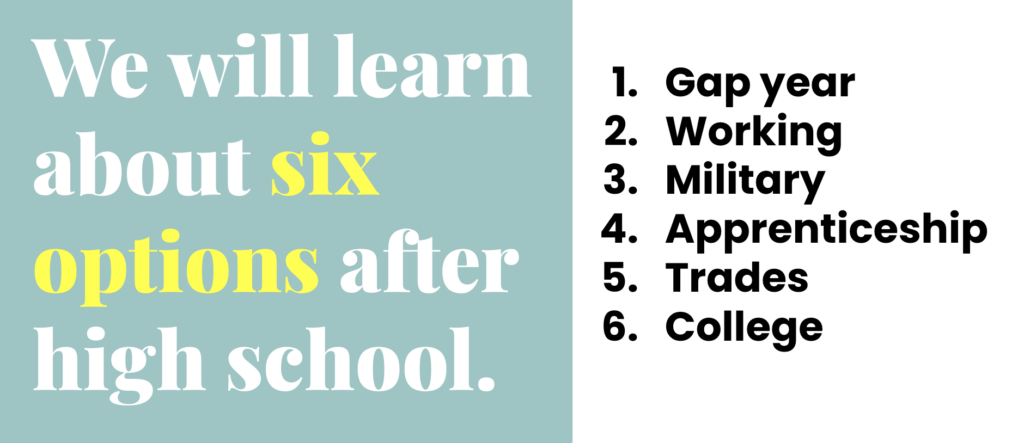Pop quiz. Which of these options after high school is the best choice?
- Taking a gap year
- Working
- Joining the military
- Doing an apprenticeship program
- Entering a trades program
- Going to college
Okay, yes, this was a trick question. Of course, there’s no correct answer.
It just depends, right?
Heck, my three brothers and several classmates from my rural high school didn’t go to college, at least not for a bachelor’s degree, and they all seem to be doing quite well. Some of them even make more money than I do as a teacher (surprise, surprise) and seem quite happy!
We all know many different paths can lead to a happy and meaningful life, but as teachers, we’re most familiar with the college path.
Although college is all many of us teachers know or what we’ve been taught is the “right” path, we need to remember to keep an open mind. This means helping our students learn about all their options so they will feel they made a wise and informed decision when the time comes.

Let’s explore the six options.
1. Taking a Gap Year
This means taking a year off, typically from school or work. What do people do during a gap year?
- Travel
- Volunteer or intern
- Study a language
- Work on a project
- Start a business
2. Working
This means joining the workforce by getting a full-time job. A typical work week is 40 hours and the most common work without a degree is in the service industry.
3. Joining the Military
This will require meeting testing (ASVAB) and physical requirements. There are six military branches of service:
- Air Force
- Army
- National Guard
- Coast Guard
- Marine Corps
- Navy
4. Doing an Apprenticeship
This is also known as a dual-training program. It’s usually long-term, on-the-job paid training focused on a technical trade and combines hands-on and classroom work (classes may be at a community college) with both hours and skills requirements. Apprenticeships can take up to six years.
5. Entering a Vocational/Trade School or Program
Similar to apprenticeship programs but shorter, a trade program offers specialized training focused on technical knowledge and skills needed for a specific occupation. Programs usually include both hands-on and classroom work and take a few months to two years. Both community colleges and for-profit programs offer professional certification in a trade.
6. Going to College
College options include a certificate and degree. Students can usually choose from different instructional modes: traditional face-to-face, online, or hybrid. There are also different entry points:
- Students who start at a community college can get a certificate or associate degree and then transfer to a four-year college.
- Students can also start at a four-year college or university and then after getting a bachelor’s degree, go on for a master’s, doctoral, or professional degree.
How do students decide on the best option?
As with anything, they should do their research and then prepare accordingly. I share a Google Slides presentation with my students to review each option, including the pros and cons of each, and then discuss and reflect.
If you would like a beautiful no-prep, done-for-you interactive Google Slides presentation on “Options After High School” to share with your students, click HERE!
My Google Slides presentation (which, by the way, is one of my best sellers) follows a complete lesson using the 5E Learning Cycle:
- Engage: Question to hook students.
- Explore: Question to activate prior knowledge and the chance to ask questions before getting into the lesson.
- Explain: An overview of the six main options after high school (gap year, working, military, apprenticeship, trade school, and college), including the pros and cons of each.
- Elaborate/Extend: The extension part of the lesson includes discussion questions and an editable survey assignment that says: “For 4 of the 6 options after high school shared in this presentation, find an adult who pursued that option and ask that person the following questions: 1) Are you happy you made that choice? Why or why not? 2) What advice do you have about this option? (Note: I linked a Google Doc with a table that students can use to show their survey results. You can use it or delete it. Also, please note that this is the only editable part of the presentation so that you can change the extension activity as you see fit; other ideas are included!).
- Evaluate: Reflection questions at the end of the presentation.
- Extra: Ideas for engaging students and extending the lesson further!
You can help your students figure out their interests and strengths by giving them skills and personality tests and interest surveys, bringing in class speakers, and suggesting they talk to others, such as counselors, teachers, parents, and friends of parents.
By the way, here are two career surveys I like:
You might also want to follow up with a Socratic seminar. Read this blog post for 10 Powerful Tips Every Teacher Needs to Have a Better Socratic Seminar.
Finally, it’s important to remind students that they should not settle or just do what their parents expect of them. They should believe anything is possible, be positive, and remember that attitude makes all the difference!

If you found this article helpful, share it with your teacher friends and colleagues!
Bold font